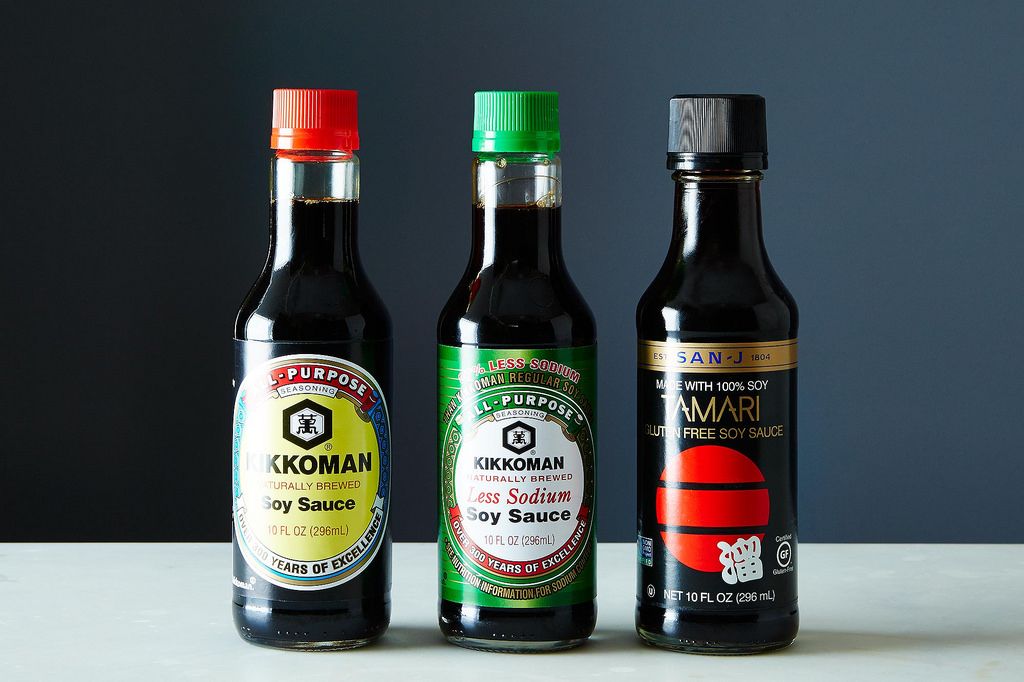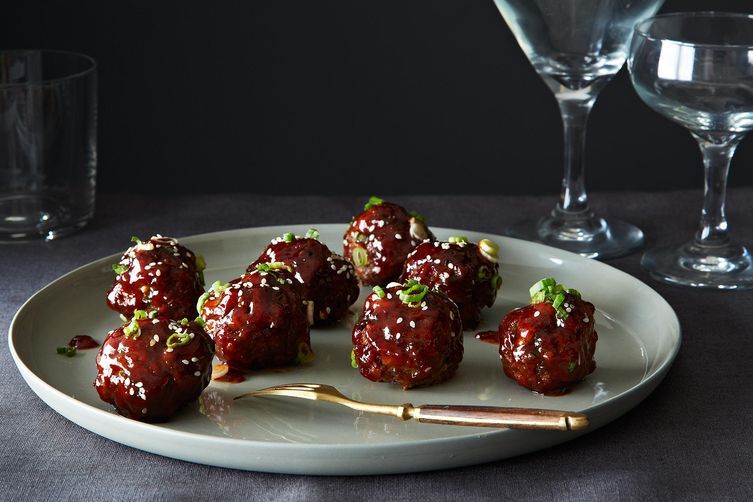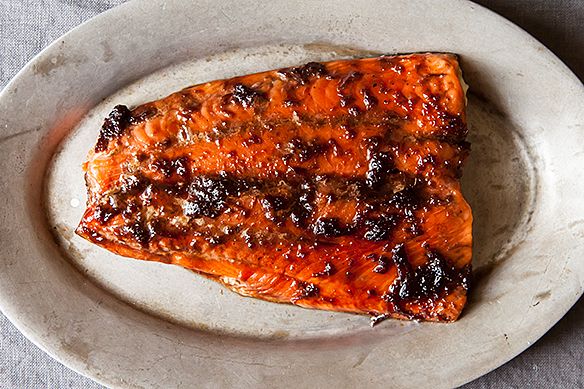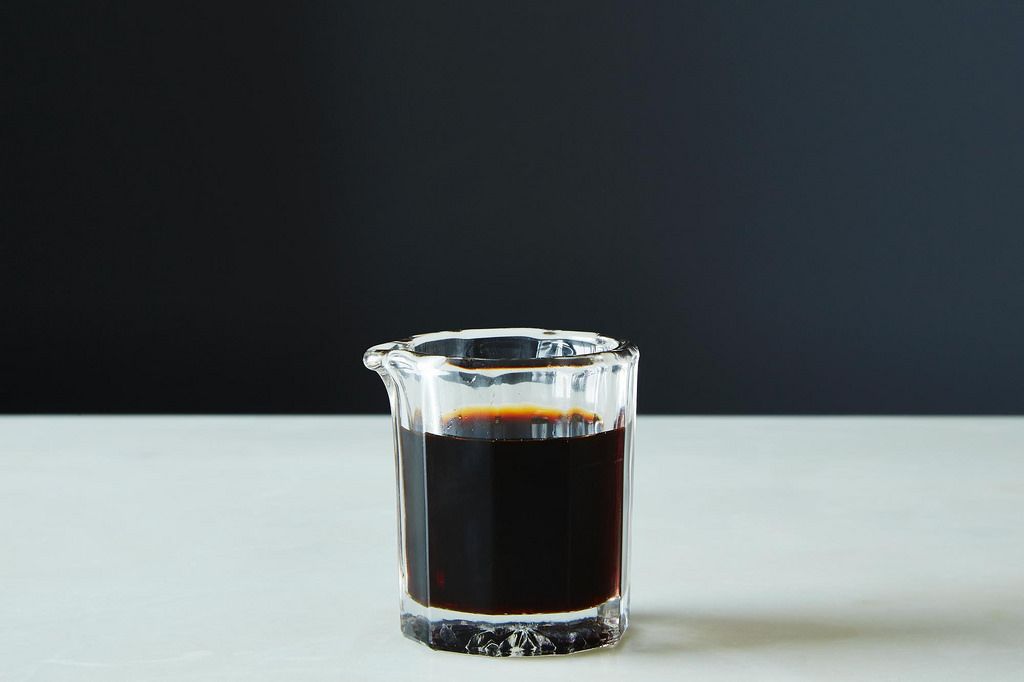Popular on Food52
40 Comments
marlene M.
October 5, 2017
We have discussed recipes with soy sauce many times and this is a very good article. Soy sauce contains a lot of sodium. I have a bottle of Kikoman less sodium soy sauce: 1 tablespoon 575 mg. Another bottle Trader Joe: 460 mg of sodium. I have been trained in Chinese cooking, which I love. I remember a great fried rice for breakfast on Food 52 that contained your total sodium for the day. When we are in good health we forget that we still need to watch out for sodium. Any suggestions?
Pat T.
October 23, 2017
Soy sauce is about both flavor and savor/salty flavor so it's hard to cut it out totally. Moderation is always key and think about using more herbs and spices for flavor, vinegar and/or sugar to balance out flavors. Pickled and preserved foods (kimchi, preserved radish, etc) also help with flavor and a little goes a long way. Of course, many of these also have a high sodium content. Nothing terribly new but I hope this will give you some options!
bas26
May 3, 2016
I use soy sauce on steaks--just rub in a few drops before grilling. It's also a good flavor booster for beef stew, turkey gravy, meatballs. A good sauce to put on salmon before roasting is mayo, soy sauce and lemon juice, all to taste.
Pat T.
October 23, 2017
I marinate flank steak in soy sauce, lemon juice, brown sugar and some sherry. Recipe is courtesy of my mom-in-law--so good! I'm going to try your salmon idea!
Vladilyich
July 21, 2015
I wouldn't be without at least a quart of a single variety of soy sauce at any time; usually I have three or four different varieties on hand. I recently discovered "Kecap Manis" and will NEVER be without in my kitchen.
I am fortunate that there is a mom and pop Asian market just a few kilometres from my house that has an entire wall with nothing but soy and other Asian sauces (another staple has become sweet chili sauce for glazes and marinades). I sincerely recommend that everyone try the Asian varieties. They are much less expensive (about half or less the price the popular brand that you find in supermarkets) and much more flavourful with many different varieties to choose from.
Another favourite of mine is mushroom soy. It has a very delicate flavour, but is difficult to find sometimes.
I pay about $5CAD/quart for the Asian varieties at my small market. I've seen the popular brand at Kroger for $5USD/4 ounce bottle.
I am fortunate that there is a mom and pop Asian market just a few kilometres from my house that has an entire wall with nothing but soy and other Asian sauces (another staple has become sweet chili sauce for glazes and marinades). I sincerely recommend that everyone try the Asian varieties. They are much less expensive (about half or less the price the popular brand that you find in supermarkets) and much more flavourful with many different varieties to choose from.
Another favourite of mine is mushroom soy. It has a very delicate flavour, but is difficult to find sometimes.
I pay about $5CAD/quart for the Asian varieties at my small market. I've seen the popular brand at Kroger for $5USD/4 ounce bottle.
I_Fortuna
July 21, 2015
HI! If you love kecap manis here is a recipe you might like. I love the stuff and it is great for a lot of Asian foods especially Indonesian foods. I was taught this recipe by an Indonesian friend many years ago.
1 pound ground beef
1 pound bean sprouts
kecap manis to taste
serve over Basmati rice
Brown and cook beef in a large skillet, add kecap manis, add bean sprouts, cover and let bean sprouts cook down, serve over cooked rice.
This is one of my favorite recipes and easy to make.
I live in a very rural small town now and I don't live near an Asian market like I used to in California but many good Asian foods can be found online.
I hope you enjoy this recipe. : )
1 pound ground beef
1 pound bean sprouts
kecap manis to taste
serve over Basmati rice
Brown and cook beef in a large skillet, add kecap manis, add bean sprouts, cover and let bean sprouts cook down, serve over cooked rice.
This is one of my favorite recipes and easy to make.
I live in a very rural small town now and I don't live near an Asian market like I used to in California but many good Asian foods can be found online.
I hope you enjoy this recipe. : )
Vladilyich
July 21, 2015
Thank you for the recipe. I saw it earlier where you posted it a year or so ago and have saved it to my hard drive. I'm making it tonight. My little market sprouts their own beans, so they always have a fresh supply on hand.
My market is run by a Vietnamese family and they carry an exceptionally wide variety of authentic foods and supplies. I discovered about 20 years ago that there is a MAJOR difference between Asian chili powder and Mexican chili powder :( That 1-lb bag lasted me almost ten years.
My market is run by a Vietnamese family and they carry an exceptionally wide variety of authentic foods and supplies. I discovered about 20 years ago that there is a MAJOR difference between Asian chili powder and Mexican chili powder :( That 1-lb bag lasted me almost ten years.
I_Fortuna
July 21, 2015
I am so glad you saw the recipe before. I had forgotten I even posted it LOL!
If you like to use heat, I recommend sambal oelek. It is a chile paste that is great for many Asian dishes. I would bet your Asian grocer carries several varieties, some even have garlic added.
Also, I use Kashmiri chile powder a lot because it has a great flavor and it is really hot! I use it in homemade red enchilada sauce. You only need a little bit.
Hope you let us know how you like the ground beef recipe. Enjoy : )
If you like to use heat, I recommend sambal oelek. It is a chile paste that is great for many Asian dishes. I would bet your Asian grocer carries several varieties, some even have garlic added.
Also, I use Kashmiri chile powder a lot because it has a great flavor and it is really hot! I use it in homemade red enchilada sauce. You only need a little bit.
Hope you let us know how you like the ground beef recipe. Enjoy : )
soysauce_lover
November 10, 2014
Great post with so useful and easy-to-understand info of soy sauces! I especially love naturally brewed Japanese shoyu. Additives and preservatives free ones definitely taste different and it makes raw fish taste incredibly better. I found and tried them here : http://www.beloved-japan.com/
At first I thought it was sort of expensive, but was worth it.
At first I thought it was sort of expensive, but was worth it.
Michael D.
September 8, 2014
I would thin out my beef stock with soy sauce and use that mixture as the "au Jus" in my French Dip sandwich. It added nice dark color and that saltiness that au jus so desperately needs.
Penny
September 8, 2014
I use soy sauce in just about everything ... gravies, stews, casseroles, pasta sauces..... it just gives a depth of flavour that is difficult to achieve otherwise.
sivanathan
September 7, 2014
Please advice what soy sauce is suitable for the steamed chicken (Chicken rice dishes)
Pat T.
September 8, 2014
If you're talking about Hainanese chicken rice from Singapore and Malaysia, it's a black soy sauce that I have yet to find here in the U.S. If you live in California where there is a significant SE Asian population, you might have better luck. My friends bring their stash from Singapore. Try a mix of dark soy sauce with molasses or kecap manis.
Pamela_in_Tokyo
September 7, 2014
I would like to add a little bit about Japanese soy sauces. Although there are a number of mammoth industrial type companies, like Kikkoman, that produce soy sauce by the thousands upon thousands of gallons, you can still easily buy artisan made soy sauce, if you know where to order.
Basically there are two kinds of soy sauces in Japan: koikuchi or dark soy sauce and usukuchi or light soy sauce. Another type called tamari shoyu is not so popular here but it is used.
Koikuchi or dark soy sauce is mostly found in the Kanto or Tokyo area. Whereas usukuchi or light soy sauce is mostly found in Kansai or the Osaka, Kyoto area.
Koikuchi or dark soy sauce although dark in color actually has less salt while the usukuchi or light soy sauce is lighter in color but has more salt. Kikkoman is considered a koikuchi or dark soy sauce, but they may make a lighter version, in that case it would be labeled as such.
Another important thing to remember about soy sauce in Japan is that it is still made by hand using traditional methods and is aged for 18 months. There are many, many companies making artisan soy sauce, each is a little different like fine wines. I only buy traditional soy sauces, one from a company that has been in business for 170 years. Another in Kyoto. Many traditional soy sauce makers produce several different styles of soy sauce from light to dark as well as others, like flavored soy sauces. Kikkoman is an industrial product made by industrial methods.
Koshi no Murasaki - in business in Niigata Pref.
Hakuō, their usukuchi soy sauce is wonderful with sashimi and fish dishes. It really does make a difference.
http://www.rakuten.co.jp/kitazawa/452042/463293/
Koshi no Kaori, their koikuchi soy sauce is perfect for Kanto style cooking.
Their home page is: http://www.koshi-no-murasaki.co.jp/
Sawai Shōyu - in business in Kyoto for 5 generations.
Another a really good soy sauce is made in Kyoto. They have been in business for at least 150 years, I believe, and is now being run by a 5th generation family member. Their company is located very near the old Imperial Palace! They make an excellent usukuchi soy sauce and a twice fermented type, both of which can be seen here: http://www.s-shoyu.com/sawai/
Their produces are available here:
http://www.amazon.co.jp/s/ref=bl_sr_food-beverage?ie=UTF8&field-brandtextbin=%E4%BA%AC%E9%83%BD%E3%83%BB%E6%BE%A4%E4%BA%95%E9%86%A4%E6%B2%B9%E6%9C%AC%E5%BA%97&node=57239051
This site offers 100 mL bottles (about 3 oz.) of artisan made soy sauces for comparison purposes:
http://www.s-shoyu.com/
Basically there are two kinds of soy sauces in Japan: koikuchi or dark soy sauce and usukuchi or light soy sauce. Another type called tamari shoyu is not so popular here but it is used.
Koikuchi or dark soy sauce is mostly found in the Kanto or Tokyo area. Whereas usukuchi or light soy sauce is mostly found in Kansai or the Osaka, Kyoto area.
Koikuchi or dark soy sauce although dark in color actually has less salt while the usukuchi or light soy sauce is lighter in color but has more salt. Kikkoman is considered a koikuchi or dark soy sauce, but they may make a lighter version, in that case it would be labeled as such.
Another important thing to remember about soy sauce in Japan is that it is still made by hand using traditional methods and is aged for 18 months. There are many, many companies making artisan soy sauce, each is a little different like fine wines. I only buy traditional soy sauces, one from a company that has been in business for 170 years. Another in Kyoto. Many traditional soy sauce makers produce several different styles of soy sauce from light to dark as well as others, like flavored soy sauces. Kikkoman is an industrial product made by industrial methods.
Koshi no Murasaki - in business in Niigata Pref.
Hakuō, their usukuchi soy sauce is wonderful with sashimi and fish dishes. It really does make a difference.
http://www.rakuten.co.jp/kitazawa/452042/463293/
Koshi no Kaori, their koikuchi soy sauce is perfect for Kanto style cooking.
Their home page is: http://www.koshi-no-murasaki.co.jp/
Sawai Shōyu - in business in Kyoto for 5 generations.
Another a really good soy sauce is made in Kyoto. They have been in business for at least 150 years, I believe, and is now being run by a 5th generation family member. Their company is located very near the old Imperial Palace! They make an excellent usukuchi soy sauce and a twice fermented type, both of which can be seen here: http://www.s-shoyu.com/sawai/
Their produces are available here:
http://www.amazon.co.jp/s/ref=bl_sr_food-beverage?ie=UTF8&field-brandtextbin=%E4%BA%AC%E9%83%BD%E3%83%BB%E6%BE%A4%E4%BA%95%E9%86%A4%E6%B2%B9%E6%9C%AC%E5%BA%97&node=57239051
This site offers 100 mL bottles (about 3 oz.) of artisan made soy sauces for comparison purposes:
http://www.s-shoyu.com/
Pat T.
October 23, 2017
Thanks for this great info on artisanal shoyu. Do you know if these brands are easily found in the U.S.A. at retail stores? Is Kikkoman really a poor choice?
marlene M.
September 7, 2014
Low sodium or reduced sodium in sauce is actually still high in sodium. 570 mg per tablespoon when the average adult can have around 2400 mg and those over 55 can have 1500 mg a day. To get around this I often mix a very low sodium soy sauce from a health store with reduced sodium soy sauce with good results.
Pat T.
September 7, 2014
Good point Marlene! If you're watching your sodium intake, please be cautious even when using low/reduced sodium soy sauce. It's always a good idea to read the nutrition facts label.
I_Fortuna
September 7, 2014
My favorite recipe using Kecap Manis or (Kejap) was taught to me by an Indonesian friend over 40 years ago. This is for meat eaters but you could sub tofu or possibly another protein.
1 pound ground beef
1 pound bean sprouts (washed well)
1 cup Kejap
Use a large frying pan. Brown the beef, add the Kejap and stir well. When the beef is fully cooked pile on ALL of the bean sprouts and cover. Once the bean sprouts have mostly cooked, stir them well into the beef and serve over white rice.
This is the most delicious recipe.
1 pound ground beef
1 pound bean sprouts (washed well)
1 cup Kejap
Use a large frying pan. Brown the beef, add the Kejap and stir well. When the beef is fully cooked pile on ALL of the bean sprouts and cover. Once the bean sprouts have mostly cooked, stir them well into the beef and serve over white rice.
This is the most delicious recipe.
Petite F.
September 7, 2014
I absolutely love tamari by San-J low sodium!! They carry organic as well. Can't beat that!!
JCCraves
September 5, 2014
Try to find Kishibori - it's head and shoulders above the other brands. Love it.
Pat T.
September 8, 2014
Just looked it up, what beautiful packaging! I'll be sure to try it out but at $16 for a 12-ounce bottle, it's going to be special-occasion only.
JCCraves
September 8, 2014
Pat it is not my daily use soy sauce but I keep in the fridge for special meals. Worth the splurge ;-)
Jan W.
September 4, 2014
San J Low-Sodium Tamari is my go-to for most Japanese/Chinese/Korean recipes. However, I also use Mikawa's shoyu varieties (Johsen Organic Shoyu and the Sakurazawa 2-Year Unpasturized shoyu) for dressings, seasoning, and of course for sushi and sashimi. Mikawa's Tamari and Shoyu are probably the best Japanese-style soy sauces I've ever tasted.
I haven't used Kecap Manis before myself but I've eaten things with it - now I might have to pick up a bottle. Also IMO Pearl River Bridge defnitely makes the best Chinese dark soy sauce I've had, but I don't see it in shops a lot here in NYC. I might have to order it online.
I haven't used Kecap Manis before myself but I've eaten things with it - now I might have to pick up a bottle. Also IMO Pearl River Bridge defnitely makes the best Chinese dark soy sauce I've had, but I don't see it in shops a lot here in NYC. I might have to order it online.
michelle
September 3, 2014
Can you recommend some high quality brands you like/use please?
Pat T.
September 3, 2014
Hi Michelle,
In my pantry I have the following:
Pearl River Bridge Premium Light Soy Sauce
San-J Tamari
Kikkoman soy sauce
Cap Bango kecap manis (sweet soy sauce)
I hope this helps!
In my pantry I have the following:
Pearl River Bridge Premium Light Soy Sauce
San-J Tamari
Kikkoman soy sauce
Cap Bango kecap manis (sweet soy sauce)
I hope this helps!
JohnL
September 4, 2014
I like to keep Pearl River Bridge Mushroom Soy on hand for some of my rice noodle recipes (e.g. Beef Chow Foon) which look anemic with light soy only. This soy is DARK and gives great color to the noodles and the beef. Do you eat mayonnaise? I have an incredibly delicious salad dressing with sesame oil and soy and also a touch of sweetness. I was going to try your recipe, but just realized my tahini has gone rancid. Time to get more. Your recipe sounds delish. I love discovering new and wonderful dressings.
Pat T.
September 4, 2014
Hi JohnL, would you like to share your recipe for your salad dressing? I'm intrigued!
JohnL
September 4, 2014
Absolutely. I'll post it now. I thought you might be vegan, that's why I asked if you are able to eat mayo.
CookOnTheFly
September 3, 2014
Coconut aminos are a great substitute for those who are GF or Paleo. Unfortunately they are not low-sodium, but a little goes a long way. Keep refrigerated.
Pat T.
September 3, 2014
I've never heard of coconut aminos but I'll look out for it and try it. Thanks for sharing.
Sd4Texas
September 3, 2014
Could you please share with me where you found that lovely little glass pouring jar at the end of this blog post that has the soy sauce in it. I love the fact that it's small buy has a pouring lip to it. Thanks so much.
Pat T.
September 4, 2014
Suzanne, try emailing the editors for that info. The photos were taken in-house. Cheers, Pat
I_Fortuna
September 7, 2014
Here is a link to some of the small pitchers like that pictured here.
http://www.montessoriservices.com/practical-life/pouring-transferring/small-pitchers
If you search on the Internet for small individual maple syrup or cream pitchers, you will find a lot. They can also be found at garage sales and antique stores. There are also many in ceramic and pottery. They are traditionally used in restaurants although some discontinued use of them because loss is too costly due to disappearance. : )
http://www.montessoriservices.com/practical-life/pouring-transferring/small-pitchers
If you search on the Internet for small individual maple syrup or cream pitchers, you will find a lot. They can also be found at garage sales and antique stores. There are also many in ceramic and pottery. They are traditionally used in restaurants although some discontinued use of them because loss is too costly due to disappearance. : )






See what other Food52 readers are saying.